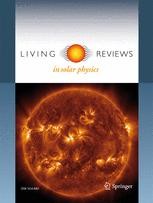Living Reviews in Solar Physics: "Historical sunspot records"
 Arlt, R., Vaquero, J.M., Historical sunspot records, Living Rev Sol Phys (2020) 17: 1. https://doi.org/10.1007/s41116-020-0023-y
Arlt, R., Vaquero, J.M., Historical sunspot records, Living Rev Sol Phys (2020) 17: 1. https://doi.org/10.1007/s41116-020-0023-y
Open Access | Review Article
Published: 26 February 2020
Abstract:
Sunspot observations are available in fairly good numbers since 1610, after the invention of the telescope. This review is concerned with those sunspot observations of which longer records and drawings in particular are available. Those records bear information beyond the classical sunspot numbers or group sunspot numbers. We begin with a brief summary on naked-eye sunspot observations, in particular those with drawings. They are followed by the records of drawings from 1610 to about 1900. The review is not a compilation of all known historical sunspot information. Some records contributing substantially to the sunspot number time series may therefore be absent. We also glance at the evolution of the understanding of what sunspots actually are, from 1610 to the 19th century. The final part of the review illuminates the physical quantities that can be derived from historical drawings.
The authors:
Rainer Arlt is a researcher at the Leibniz Institute for Astrophysics Potsdam (AIP), Germany. He is interested in solar and stellar dynamos, magnetic instabilities, and the differential rotation of the Sun and stars. He is analysing historical sunspot observations for the understanding of the solar cycle, and is also interested in photographic plate digitization and meteor astronomy.
José Manuel Vaquero Martínez is professor in the Physics Department of the University of Extremadura, Spain. He is interested in the reconstruction of solar activity and Earth climate during the last centuries from documentary sources. With Manuel Vázquez he co-authored the book "The Sun Recorded Through History" (Springer 2009).
